Laurent Dubois's Blog, page 62
January 14, 2016
Le football et la foule sportive
Dans son livre Le match du football. Ethnologie d’une passion partisane à Marseille, Naples et Turin, l’anthropologue Christian Bromberger analyse la sociologie du football, y compris la foule sportive qui a «un statut mixte, hybride, intervallaire balançant entre l’affirmation d’une volonté collective et l’appréhension lucide d’appartenances singulières, entre la conscience aiguë de ce qui se dit et se fait et le débridement des émotions» (210).
Dans l’article de Bromberger que vous avez lu cette semaine, il décrit le jeu comme une sorte de rituel : « [le football] gives the group the opportunity to celebrate itself by performing and displaying itself, both in the stands and on the pitch » (311). Comme le Professeur Dubois montre dans son post, le film Zidane, un portrait du 21e siècle exemplifie ce côté ritualistique du football. Sorti en 2006, ce film expérimental suit Zidane en temps réel pendant les 90 minutes d’un match du Real Madrid contre Villareal CF au stade Santiago Bernabéu à Madrid.
Le film communique son message à travers la forme, pas forcément à travers des méthodes conventionnelles comme la narration. La réponse des critiques au film a été mitigée, certains l’ont vu comme une œuvre d’art et d’autres comme un jeu de marketing. Vous pouvez accéder à un résumé des critiques ici :
http://www.allocine.fr/film/fichefilm-56722/critiques/presse/
Mais comme le Professeur Dubois l’a bien souligné, notre perception et opinion du joueur Zidane influent sur nos réactions au film.
Cette semaine, vous allez écrire un commentaire qui répond à la fois à la lecture de Christian Bromberger et au film Zidane, un portrait du 21e siècle. Identifiez dans le film des moments-clés qui vous semblent pertinents à la lumière de votre lecture de « Football as World-View and as Ritual ». Quels sont les points essentiels de l’argument de Bromberger? Est-ce que vous trouvez les mêmes composantes dans le film ?
Ecrivez des phrases entières et en français dans la section commentaires ci-dessous avant 17h00 (5 p.m.) mercredi le 20 janvier.
January 13, 2016
Football as Ritual
The French anthropologist Christian Bromberger has studied and written about football games as a kind of ritual that provides an “inexhaustible terrain of interpretation” for those who participate and watch. In his French-language book “Le match de football,” he studied how crowds experienced and interpreted games in the European football heartlands of Marseille, Milan, and Naples. He condensed the theoretical conclusions he came to through this research in his 1995 article “Football as World-View and as Ritual.”
One of the more remarkable works that captures the form and content of this ritual is the 2006 film Zidane: A 21st-Century Portrait, by the film-makers and conceptual artists Douglas Gordon and Phillippe Parreno. On April 23, 2005, they installed seventeen cameras in the Santiago Bernabéu Stadium in Madrid to film a full game between Spanish Liga teams Real Madrid and Villarreal CF. But they focused the cameras not on the ball, but rather on one entrancing player, Zinedine Zidane, considered one of the greatest footballers in history. The full film is below.
Since it’s release, the film has garnered effusive praise from some quarters and sharp criticism from others. While it had a long run in theaters in France as well as being shown commercially in the U.K. and other European countries, in the U.S. it has only been shown in small art houses and film festivals.
The film’s directors, Douglas Gordon and Philippe Parreno, have a background on experimental contemporary art, including video installations, and the film is also clearly an experiment. (Whether it is a success of failure as such is the key question). Like many other experimental films, it presents its argument not so much through narrative or exposition but through form. It is, among other things, an attempt to represent sport in a way that is radically different from the kinds of portrayals were are used to, which either provide us a global picture of live game or else highlights that emphasize the climaxes of the game over the empty spaces in between. Of course, it is also a portrait of Zidane, and the reactions to the film also have much to do with the very different ways people see him as both a player and an icon.
Here are two interesting discussions of the film
This week in the “Soccer Politics” class at Duke University, we are asking the students to post comments in response to this post that bring together their reading of the 1995 Bromberger article on “Football as World-View and as Ritual” with a viewing of Zidane: A 21st-Century Portrait. Specifically, we are asking them to find specific moments in the film that speak to or illustrate specific points made in Bromberger’s article about how a football match works, and we can see within it. In doing so, we ask them to share specific quotes from Bromberger along with specific moments in the film (identified according to the time on the Youtube video above). (Students, please post your response in the comments section below by 5 p.m. on Wednesday January 20th).
We also welcome other comments about the article and film!
November 15, 2015
The Stade de France: A History in Fragments
The French national team player Patrice Evra was dribbling up the pitch when the second bomb exploded. Two minutes earlier, the same thing had happened: a loud, resonating explosion heard by the 65,000 fans gathered to watch a friendly match between Germany and France. There was a wave of shouts – not quite a cheer, almost something like tens of thousands of people saying “whoa,” or “what”? – but no panic. People mostly seem to have thought it was a loud firework, perhaps a flare exploding in one of the tunnels. Football games are full of noise, after all, and sometimes explosions. So the game went on. . . .
Read more at Africa Is A Country
November 14, 2015
Lassana Diarra’s Statement on the Paris Attacks
Lassana Diarra issued a statement about the Paris attacks today. Here is the original. Below is a translation of the statement.
“In the wake of the dramatic events that took place yesterday in Paris and Saint-Denis, it is with a heavy hard that I speak today.
As you have perhaps read, I was personally touched by the attacks. My cousin, Asta Diakite, was one of the victims of the shootings that took place yesterday, like thousands of innocent other French people. She was a reference point, a source of support, and a big sister to me.
In this climate of terror, it is important for all of us who represent our country and its diversity to speak out and stay united in the face of a horror that has neither color, nor religion.
Let us together defend love, respect and peace. I thank all of you for your comments and messages. Take care of yourselves and others, and may our victims rest in peace.”
August 27, 2015
Broken Managers – The Process and Consequence of Losing the Dressing Room
It’s not uncommon for a bloke in England watching a football news program to hear the phrase “manager lose the dressing room”. An idiom referring to a situation in which the players cease to respect and follow their manager’s instructions, this phrase is such a popular term to use in speculating any disputes within a football club, not least the potential resignation or sacking of the managers. Indeed, countless articles and documentaries about football managers emphasize the managers’ ability to not only structure tactics and plan training sessions, but also to persuade their players to buy into their managing style.
Then such emphasis begs the question – how do managers lose the dressing room? Media usually attributes such massive loss of respect towards a manager to one or several particular moments. I distinctly remember a commentator referring to Bolton Wanderer’s 5-0 defeat against Stoke City in the FA cup semi-final in season 2010/11 as the moment when the then-manager Owen Coyle “was never the same figure in his dressing room”, leading to a dismal run of performances in the next two seasons, before he got sacked during season 2012/13. A 2012 ITV documentary of Jose Mourinho also highlights Chelsea’s 2007 Champions League semi-final loss against Liverpool as the moment when the relationship among him, his players, and the club owner Roman Abramovich deteriorated to a point where Mourinho felt “it was all gone”.
Crude it may seem at the first glance, such analysis is intriguingly plausible, given how difficult it is for a manager to maintain a sense of respect from his/her players, and how such respect could easily vanish in the most trivial of all matters. The often downplayed truth is that managers, like referees, are generally regarded by the others with contempt rather than admiration. As Eduardo Galeano portrays in his book Soccer in Sun and Shadow, managers are the ones that limits and shackles the players as mere parts of his arbitrarily designed tactical system, and denigrates a “play” down to a “work”. If managers’ blandification of players and the game of football in general are all for the purpose of delivering success, then specific occasions that represent failure in achieving such purpose might be more than enough a reason for the players and the spectators to lose faith towards their managers. Another season’s worth of payment and sacrifice for absolutely nothing, they would think.
Would it be possible for managers to repair the damaged sense of respect from their players and fans? I doubt if such feat has been achieved in any type of organization, let alone in the world of football. The closest counterexample would arguably be Alan Pardew’s time as a manager in Newcastle United, in which Pardew did manage to persist during periods of extreme hostility from the Newcastle fans in 2014 to upturn Newcastle’s poor run of form. Even he, however, walked out of Newcastle not long after, opting for a shift to Crystal Place where he felt he could receive a full support and respect from the fans and the players. If such loss of respect are triggered by those particular moments of downright failure, which is bound to happen at least a handful in every season; if such loss cannot be repaired even after the managers did manage to produce better results; then perhaps it might be impossible for the broken managers to rejuvenate their careers in the same club – A remarkable parallel to the Johnsons and Nixons in the real world.
July 28, 2015
Creating a Space for African-Americans in U.S. Soccer: Guest Post by DeVon Thompson
Guest post by DeVon Thompson
My name is DeVon, I am a soccer fan, a player and a hip-hop writer and blogger. I grew up in suburban America, a black girl who turned soccer at recess into a full-fledged childhood career with a local rec team. I was the quintessential suburban American soccer story, and then I played basketball and moved on track as a sprinter.
Through the years I’ve maintained some level of playing, whether in leagues or playing soccer with the kids at the day camp where I was a camp counselor – we played serious pick up, one counselor per team. The most important part is that from childhood I’ve always remained a fan, watching the World Cup, attending international games here in the states, watching the Premier League, La Liga and the French league (which I feel should be shown more in the US) and MLS. It is the fan in me that has led me to write this article. While I grew up in the well-managed and maintained leagues and fields of suburban America, I was mostly one of one when it came to soccer teams – by which I mean one of one black kids. Honestly that bothered me. I’d like to address the issue of the lack of black American participation in soccer either as fans or players.
There is an invisible wall in the U.S., and while many black Americans play soccer and go on to play at various levels, there are many more don’t! Soccer in the U.S. has become American in its way, and in the process has absorbed everything here including racial issues. Many black people still view soccer a “white sport.” While many Americans who dislike the game comment is “boring,” “slow,” or “uninteresting,” – and let’s be honest, just downright “foreign” – in the black community what can be heard is just that it’s a “white sport.”
Growing up as a middle-class black girl, I felt that I was participating in something that many blacks just didn’t. That was partly because living in the suburbs it afforded me the opportunity to participate in something uniquely suburban. My participation was encouraged and well-attended by various families, from my parents, grandparents, cousins, aunts and uncles – and yes orange slices were on hand for all to enjoy. I could have played soccer until I couldn’t play anymore and it would have been 100% supported by family. The thing was, on the field I was always just one of one, not to mention I was one of one in my entire immediate family. I eventually left organized soccer behind to play basketball year-round, pursuing the ultimate child hood dream of playing varsity, my decision was 100% supported. My soccer cleats were left in the garage to be thrown away years later.
It wasn’t until I was an adult that my enthusiasm for soccer flourished again, now as a fan. But once again I was one of one. Now a little older, I looked at the overall picture and thought: “Where are the black kids, where are the black people!?” I can have an in-depth conversation about soccer with many whites I encounter. It feels almost like a club. Although my family and friends will wax poetic about basketball, baseball and lose their minds when talking about football. But when I bring up soccer and I get comments like: “You always were into that, but I just can’t get with it.” Being a black American soccer player & fan feels almost like a hobby, like I should have a special license plate that says “Black American Soccer Fan.” My conversations with fellow black American soccer enthusiasts feel more like therapy sessions. While some say not to worry about it, I can’t help it: I don’t want to create my own sorority or fraternity of soccer fans. I want to have free flowing conversations. I want to say to someone: “I’ve got tickets to a game” and have them say “Sure, let’s go!” the way that would if it was basketball or football.
“What is going on? What is the problem?” I’ve wondered this for years. “Why? Why?’ It was an article in the Huffington post about race in Canada, interestingly, that helped me to understand what is going on. It argues that minorities in Canada need more “safe spaces without white people.” Which made me realize: when it comes to sports in the U.S. black Americans have created their own spaces! If you look at the ‘Big 3′ in the U.S. – football, basketball and baseball – there has always been a space for black people in each of them, for close to a hundred years. These spaces were created, sadly, due to segregation. But they became safe spaces, places for the black communities to gather and play and be spectators. The Negro leagues in baseball were the most organized, but such spaces existed in all of these sports. Within them, black Americans had their own corners to just be!
Soccer is different. White America has created its own space for the entire game. To me it feels somewhat like a twilight zone. The way the entire game has developed in the U.S. has made it largely a white space, a white place. I have to admit that nothing is absolute and that when it comes to soccer in the U.S. there are many layers and I’m here exploring one of them, however there have been a few times when I played in an adult rec league, once again one of one, I would get looks that say: “I have a million questions.” When people experience my knowledge of the game, even just the understanding of the basics, it’s always as if someone wants to say: “How do you know this?”
In this sense the U.S. is its own bubble when it comes to soccer, Here, though, it’s hard to see outside of that bubble. There are some serious attempts going on to change things. But I’d like to suggest that maybe the best way to confront this problem is through a slightly different sport: FUTSAL!
Yes! Futsal could be that space that black Americans and really all of the U.S. needs to take us to the next level. The first time I played it was just because I was really looking for a way to play soccer that wasn’t in the cold and didn’t require me to keep running the length of a football field. After one game I thought: “Why isn’t America playing this game!??” Again (you guessed it), I was one of one. And immediately I thought: “Why aren’t black kids playing this game!??” It is the perfect way to start for people who don’t know about the game.
Futsal is essentially played on basketball court. There are two 20 minutes halves, a total of five players on each team on the court. For me, it combined my two personal favorite sports: basketball and soccer. It can’t get any better! It is quite different from the curator space of U.S. soccer played on Saturday mornings and weekday afternoons. Futsal is free-flowing and much higher scoring: it is a perfect form of translation between the more popular U.S. sports and soccer. There are basketball courts everywhere in the U.S., if there isn’t a court there is a street or an alley. The rules are simple and you can play it in basketball shoes if you want – I’ve seen it done.
The game of Futsal could be a way to create spaces for black Americans in a sport where there isn’t any already. Futsal allows someone to re-create what they already know: it welcomes a basketball mindset, with a smaller soccer ball on a basketball court. The U.S. has to work what it has and create something we can grow from. It’s an honest truth in sports in the U.S.: if you want something taken to the next level it has to include black Americans. But there needs to be a better space for development.
July 27, 2015
Upfront/Onside: Dispatches from The 2015 Women’s World Cup
I had the opportunity to help set up and edit and also contribute to a blog called “Upfront/Onside” set up at Sports Illustrated to cover the Women’s World Cup this summer in Canada. The blog brought together authors who had earlier gathered at the “Futures of Women’s Soccer” conference here at Duke in April.
Here are links to my pieces:
On France’s Jessica Houara and the issue of the Hijab in Women’s Football (co-authored with Shireen Ahmed)
A First-Person Account of the France-Germany Quarter-Final
A First-Person Account of the USA-Germany Semi-Final (co-authored with Brenda Elsey)
May 1, 2015
Les Coiffures des Footballeurs
Après avoir lu cette poste de ESPN FC sur les différentes coiffures de David Beckham, il m’a fait me demander pourquoi le monde du football est plein de coiffures pas orthodoxe. Premièrement, nous examinera quelques catégories de coiffures et après je vais donner quelques pensées sur cette phénomène de coiffures intéressantes dans le monde du football.
On peut diviser ces coiffures dans trois catégories:
haut et serré
dessins artistiques
déchainé et indiscipliné.
Haut et serré:
Probablement le style de coiffure le plus à la mode maintenant, la coiffure haut et serré est partout dans le monde du football. Pour faire une coiffure haut et serré, on doit couper les côtés très court tout en laissant une certaine longueur sur le sommet. Il existe quelques variations dans les coiffures haut et serré dans le monde du foot et voici plusieurs.
Olivier Giroud, Milieu de terrain, France/Arsenal
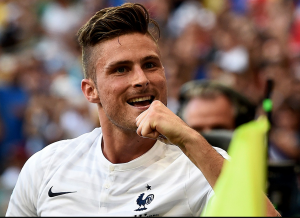
Par Anne-Christine Poujoulat/AFP/Getty Images
Giroud porte un haut et serré relativement conservateur, mais la longueur du sommet est assez unique.
Mario Balotelli, Attaquant, Italie/Liverpool FC
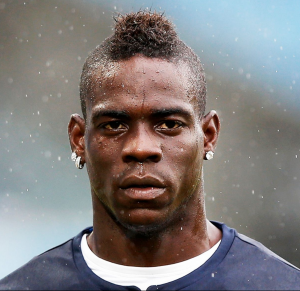
Reuters/Tory Hanai
Balotelli, un joueur animé et controversé, ajoute un peu de style à la catégorie haut et serré avec cette coiffure.
John Boye, Défenseur, Ghana/Kayseri Ersiyesspor
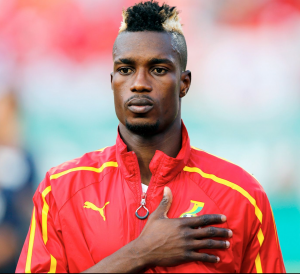
Reuters/Wolfgang Rattay
Un peu similaire à le haut et serré de Balotelli, Boye laisse plus de cheveux sur le sommet et ajoute deux lignes blanchies.
Dessins artistiques:
Avec ce style de dessins artistiques, les footballeurs ont beaucoup de liberté et ils peuvent montrer leur créativité. La seule règle de cette catégorie est qu’il doit y avoir une sorte de dessin. Souvent ils emploient un haut et serré en combinaison avec un dessin artistique.
Asamoah Gyan, Attaquant, Ghana/Al Ain
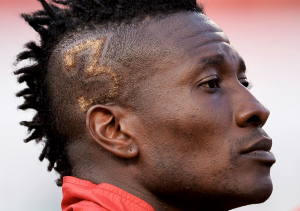
Mladen Antonov/AFP/Getty Images
Dans cette coiffure d’Asamoah Gyan, il conçoit sa numéro dans la coté de son tête.
Nani, Milieu de terrain, Portugal/Sporting CP
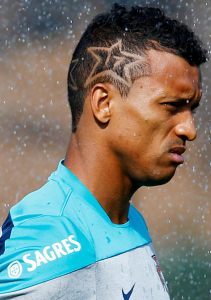
Reuters/Mauro Horita
Très similaire à la coiffure de Gyan, Nani encircle sa numéro dans une étoile.
Cristiano Ronaldo, Attaquant, Portugal/Real Madrid
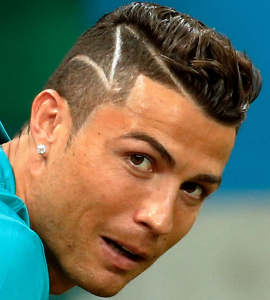
Reuters/Siphiwe Sibeko
Comme son coéquipier, Ronaldo ajoute une certaine élégance à sa coiffure haut et serré avec un dessin artistique modeste.
Déchainé et indiscipliné:
La catégorie déchainé et indiscipliné est quelque peu auto-explicatif. Ces coiffures sont marquer par une longueur de cheveux et dégagent une ambiance indompté. Pensez à la crinière d’un lion…
Kyle Beckerman, Défenseur, USA/Real Salt Lake
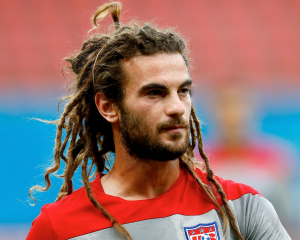
Kevin C. Cox/Getty Images
Beckerman porte les dreadlocks longues en donnant une ambiance décontracté, main intense.
Guillermo Ochoa, Gardien de but, Mexico/Málaga
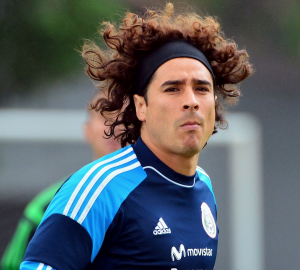
Yuri Cortez/AFP/Getty Images
Tout simplement, Il semble que Ochoa refuse de couper ses cheveux. Il doit porter un bandeau pour contrôler ses cheveux et aussi pour voir et arrêter le ballon.
Mais pourquoi ces coiffures pas orthodoxe? À mon avis, votre apparence dans les sports est très important pour vous-même, mais aussi pour faire une impression sur votre adversaire. Habillant bien vous donner de la confiance, et votre coiffure est un grand partie de cela. La coiffure peut être intimidant, mais aussi votre coiffure peut montre votre confiance en vous-même. Il faut une certaine confiance pour obtenir une coiffure pas orthodoxe. Ou peut-être ces joueurs sont un peu fous en portant ces coiffures bizarres, je ne sais pas…
[1] World Cup Hair. (n.d.). Retrieved May 1, 2015, from http://espn.go.com/espn/photos/galler...
[2] SoccerWiki.org. (n.d.). Retrieved May 1, 2015, from http://www.soccerwiki.org/player.php
Pellegrini Out?: Evaluating Manchester City’s Manager Options
The NBC Camera zooms in on Pellegrini’s eyes after a rough derby loss
Manchester City is teetering on a crisis. Since the new year, when they were tied with Chelsea atop the table , they have struggled, and are now sitting 13 points behind the soon to be champions. Not only that, but the team has looked poor doing it, showing little drive or defensive structure. Manchester City supporters are questioning his leadership and ability to motivate his players. The agent of city’s star midfielder, Yaya Toure, called Pellegrini “a good coach, but a weak manager.”
Despite all these problems, Manchester City still sit in second in the Premier League, and it cannot be forgotten the Pellegrini led City to the Premier League championship and an F.A. Cup victory last season. Pellegrini was told to win “five trophies in five years,” and he is still on pace with two after two seasons. Pellegrini has been proven to be a good player, it is not necessarily his fault the players are not performing. However, some of the blame likely can be placed on the calm Chilean for inability to motivate his players, as he is not known as a motivator.
Calling for the head of a manager as he sits in second seems ridiculous, but it is the current soccer culture, as James Peek noted in his recent blog post. The fire under Pellegrini got notably stronger when Jurgen Klopp released that he would be parting ways with Borussia Dortmund at the end of the season. Apparently, the City management are keen on Klopp. The attraction is understandable; Klopp is known as an energetic motivator who has gotten great results, winning the Bundesliga in 2011 and 2012, the DFB-Pokal in 2012, as well as reaching the Champions League final in 2013. Many City fans want the stability Peek writes about in his post, but it is hard to ignore Klopp and not imagine how he could fit in at Manchester City.
Personally, I think Manchester City should wait it out and see how Pellegrini does in his final four games. If City finish strong, and take second place with good performances I think Pellegrini should stay, as stability is important and second place is not shabby. However, if Manchester City drop to third or fourth and continue to demonstrate the laziness and disinterest that has plagued the team lately, the City back room management would be foolish to not reach out to Klopp, who has repeatedly shown his worth as a coach. What do you think? I’d like to hear – comments are welcome below.
April 30, 2015
El estadio, el templo
En 2012, fui a mi primer partido de fútbol a mirar los Red Bulls de Nueva York versus los Tottenham Hotspurs. Era el tercer verano Thierry Henry, un jugador francés muy famosa, jugó por los Red Bulls. Senté en la sección de los hinchas de los Red Bulls e inmediatamente cuando los jugadores entraban el estadio, los hinchas se volvieron locos. Estaban en la presencia de realeza: Thierry Henry había jugado por AS Monaco, Juventus, Barcelona, y era el máximo goleador de todos los tiempos en Arsenal. Por la totalidad del partido, las hinchas alentaban los Red Bulls. Aunque los Red Bulls perdieron a los Hotspurs dos a cero, la experiencia en total era como ninguna otra.
Christopher Gaffney en su libro “Temples of the Earthbound Gods” afila en dos grandes capitales del fútbol: Buenos Aires y Río de Janeiro. Utiliza una metodología de urbanismo comparativo para demostrar que mediante la comparación de eficacia estadios en Buenos Aires y Río de Janeiro, uno puede entender mejor cómo las ciudades y sus culturas deportivas en general operan. Él dedica dos capítulos a cada ciudad y hace un análisis histórico y contemporáneo de los estadios en sus espacios urbanos. El primer capítulo trata de demostrar al lector por qué los estadios son elementos culturales significativos debido a su capacidad para mantener una presencia geográfica física, cultural y social en un nivel microcósmico y cómo se facilita las interacciones humanas entre distintos actores socioeconómicos en una escala masiva. Los capítulos dos y tres direcciones del desarrollo del fútbol brasileño y la evolución de los cuatro estadios principales de Río de Janeiro, mientras que los capítulos cuatro y cinco dirección de la evolución del espacio y la cultura urbana en Buenos Aires, la masculinidad y la violencia de la cultura estadio, la comparación de las experiencias del estadio entre rugby, polo y fútbol en Buenos Aires.
Quiero pregunatar sobre la erudición existente sobre el desarrollo del fútbol-político elaborando más en la falta de una voz femenina en la cultura. Gaffney describe los estadios como “espacios masculinos” y profundiza en la “conciencia pública sexual-espacial” que facilitó la segmentación de género de la sociedad en la que se espera que las mujeres para trabajar exclusivamente en el ámbito doméstico, mientras que los hombres dominan espacios más sociales en Buenos Aires. Pienso que la voz femenina en el fútbol debido a que el espacio parece ser extremadamente género no sólo en el supuesto de la masculinidad, pero también agresiva proponiendo él. Gaffney luego hace una comparación cruzada entre las culturas del estadio en Buenos Aires y Río de Janeiro un enfatiza cómo estadios en ambas ciudades están experimentando cambios que son paralelos a los procesos políticos, económicos y sociales más grandes y cómo el desarrollo cultura estadio puede actuar como una herramienta de medición de estos cambios en la cultura urbana.
Quiero hacer una investigación entre el desarrollo entre la organización fútbol de Argentina y las politítcas nacionales cuando estudio en Argentina este otoño.Espero hacer un estudio etnográfico sobre la cultura estadio durante los partidos y el trabajo pionero de Gaffney en los estadios y su importancia como espacios urbanos microcósmicas proporciona conocimiento vital, fundamental en mi investigación. Creo que va a ser muy útil en mi investigación para tomar la entrada de Gaffney en estadios son medidas de cambio y desarrollo porque hay amplia evidencia de que los estadios pretenden un papel importante en la interrelación entre el fútbol y el desarrollo político.
Laurent Dubois's Blog
- Laurent Dubois's profile
- 44 followers




